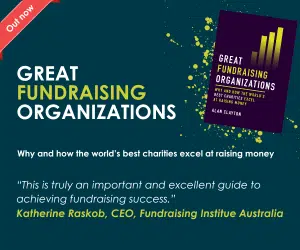“How many different types of fundraising are there?”
“I have a bit of a problem with this question. It seems to position fundraising as an ‘activity’.”
A recent post on Facebook asked:
“Friends, can you help me out?
“I want to draw up a list of as many different types/disciplines of fundraising as I can think of. Legacies, Trusts & Foundations, Individual Giving, Community etc… Also, for a hypothetical charity starting from scratch, is there a usual/common process by which they would grow a fundraising strategy ie starting off with T&F fundraising, then adding corporate support capacity etc?”
Advertisement
I responded:
“Those who know me will understand why I have a bit of a problem with this question. It seems to position fundraising as an ‘activity’.
“Let me give you an example. It is true, and far from unusual.

“A High Street shopper sees a charity display in a shop window, and goes in and buys a specially designed t-shirt. She’s a donor. The people in the company who decided to partner with the charity are donors. They decided on the way to fundraise, not the charity. The designer who designed the t-shirt is a donor.
“The Chair of the company was engaged by a major donor. The major donor’s wife chairs a local community fundraising committee. Of course, she is a donor.
“And this thinking is not just for large charities. A small, local charity has more opportunities for this integrated approach to its supporters than a large national one.”
May I unpack this a bit?

Of course, there are techniques. There always have been and there always will be. In the example I often quote of the building of Troyes cathedral starting in 1389, there are types of fundraising which we would recognise today: major gifts, collecting boxes, regular gifts and corporate partnerships.
And there were some which we wouldn’t recognise: the sale of indulgences, the granting of general pardons, funerals with different degrees of pomp, the sale of relics, payments made for the remembrance of a donor in the form of prayers, or a Mass.
You may regard the selling of relics as ‘trading’, but how would you categorise the others?
And, although I don’t know it as a fact, there will have been different, paid, people, with different skills, for them all. (The profession of fundraising is not new.)
And, and forgive me if I am stating the obvious, an Individual Giving fundraiser today needs certain skills and experience. Testing of different creative approaches with focus groups. Satisfaction surveys. Rigorous analysis and segmentation. All as a means better to understand the donor.
(And so give the donor a better experience, and so raise more money and help more beneficiaries. May I, now, take this as read?)
A corporate fundraiser will require quite different skills and experience. Indeed, a corporate fundraiser negotiating a partnership with the influencers in a company will need different skills from those delivering the partnership. (Is this contentious?) But for both, their work is better to understand the donor.
So, different donors require different skill sets from the fundraisers who engage with them.
And, yes, there are different sources of funds. I am deliberately not going to list the obvious ones, because they exclude the less obvious ones.
What about the t-shirt shopper, a donor, who I mentioned earlier? And where would you place the National Association of Flower Arranging Societies, an enormous and unknown organisation who gave very significantly to NSPCC’s Centenary Appeal? (Or rather their members did.) And where would you place the collections via Football Match programmes during the Full Stop Appeal, which involved several partnerships with different people and different organisations, but where the actual money was given by individual football team supporters?
And the Facebook post talked about ‘Trusts and Foundations’. And most of us do. But do we all distinguish between family trusts, which in many cases are a vehicle for a major donor/philanthropist (Is there a difference?) to give away money tax effectively? And institutional trusts with their complicated application forms?
And do we believe that trustees, and trust administrators, can’t be influenced by the experience they receive? I assure you; they can, despite trust administrators stating absolutely they don’t. They do.
(If I have made my point, skip the next bit.)
Retail. Do you include jumble sales? Car boot sales in a stately home? A free, short-term lease on a shop, run totally by volunteers? One of a chain of shops with paid managers?
Street fundraising. Static collection boxes? The bucket collectors out in force for Poppy Day, Daffodil Day, or the Macmillan World’s Biggest Coffee Morning? The flag day collector? The paid street fundraiser recruiting new direct debits?
Companies. Collection boxes placed by volunteers in the local shop? A partnership with a national company? Or a local company? Company donations? CSR initiatives? Promotions? Sponsorship? Staff fundraising? Major individual gifts from top management?
Door to door. The traditional collections: volunteer committee members putting envelopes through doors? Paid fundraisers signing up direct debits? Bob-a-job week? (Now called Scout Community Week.)
Mitzvah day. And what about other religions and their fundraising?
Volunteer committee fundraising. In a village, though a cake sale raising £500? A tiny charity with an ambitious fundraising committee which raises £50,000 from an auction? A Volunteer committee for a £10m Appeal? Or a £250m Appeal? Or anything in between?
Challenge events. Mass participation events. Schools fundraising. Sponsored walks. Rag weeks. I could go on.
And I suggest none of these distinctions is real. They overlap.

And in the last ten years. The growth of crowdfunding. And the ability to put a device into a shop window, or other window, which lets you donate, say, £5 for the cause simply by tapping your card on the outside of the window. It’s news right now. (UK Fundraising, 4th December 2018).
Given the way fundraising has changed in the 50 years that I have been a fundraiser, is there any reason to suppose it will change less in the next 50 years?
Or will the change be exponential, as it always has been in every walk of life? (Scary; isn’t it?)
(Please start reading again, now.)
Whether you talk about trusts, companies, major donors, community volunteers, marathon runners, individual givers or whatever, you are talking about people.
Individuals with their own motivations. And, their own ways of wanting to engage, financially, with our causes.
And whilst legacies is indeed a source of funds, they are left by individuals, who may well be donors of some other form.
So, we should start with people. The only reason to talk about “types/disciplines of fundraising” is as a means to reach people.
Because we have to organise ourselves internally, we categorise these types of giving: ‘Individual giving’, Community volunteers’, ‘Companies’ etc. But these are merely constructs to help us organise ourselves. They bear little resemblance to the real world.
There are probably an infinite number of different types of donor, and an infinite number of “types/disciplines of fundraising.” (I exaggerate. Let’s just say ‘lots’.)
It might help if I address the second part of the original Facebook question.
“Also, for a hypothetical charity starting from scratch, is there a usual/common process by which they would grow a fundraising strategy ie starting off with T&F fundraising, then adding corporate support capacity etc?”
No, please. Don’t just start with T&F. Again, this is starting by talking about types/disciplines of fundraising, not starting with people.
So I would advise a different approach for the hypothetical charity.
1) Who are the founders? Who are the current trustees? What supporters do you have already? Who else is engaged with the charity? Are they wealthy? Are they influential? Where is their influence?
2) Where is your constituency of support? Do you have mass appeal, or are you very niche?
3) Are you national, local, or very local?
4) Would you be able to set up a volunteer committee? At a grass roots level, organising local events? Or at a level that could attract major gifts or company support? Or somewhere in between? Or both?
5) What are you aiming for? What resource is available for fundraising? I’m sure there are other questions. These are off the top of my head.
Once you have answered these questions, you need a plan. Three years? Only then should you decide where to start.
Just to take a couple of examples.
If you are a hospice within a small community, you may well want to engage the members of that community. The local businesses. Local organisations. The Mayor might help you identify local wealth.
Start by inviting all these people to one gathering, at the hospice. Engage them.
If you have a slightly larger area, you might consider starting with the local community foundation, and work out from there.
Or, you might indeed start with a programme of approaches to Trusts and Foundations. But you will have gone through a process, with some rigour.
My conclusion is simple, and may seem obvious.
Start with people. Your existing supporters and potential supporters. Then decide, from the myriad of possibilities, how best to reach them. But don’t structure your fundraising plan by starting with a list of types/disciplines of fundraising.
You are you. You are unique. You are addressing a specific need. People and organisations will want to engage with you, and support you.
Start there.
Giles Pegram CBE
Consultant
15.xii.2018








